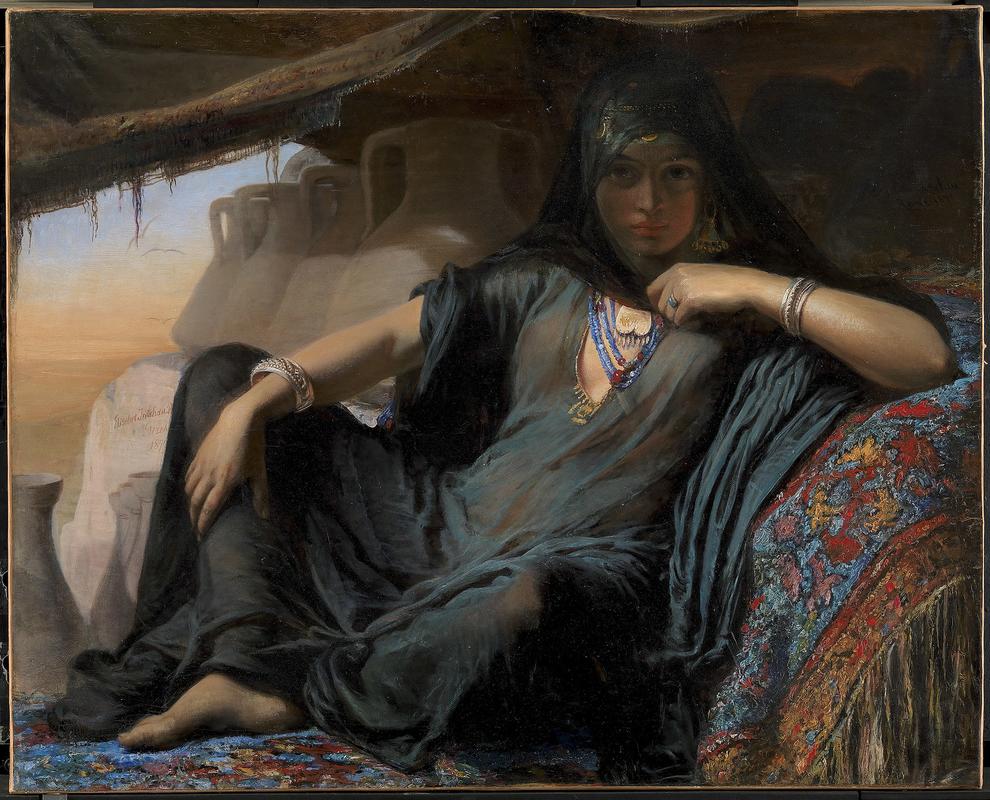More about An Egyptian Pot Seller at Gizeh

Sr. Contributor
Elisabeth Jerichau Baumann painted An Egyptian Pot Seller at Gizeh either during or upon her return from trips to Turkey, Greece, and Egypt in 1869-1870 and 1874-1875.
She had previously traveled to the Middle East, North Africa, and Persia in the 1850s with her husband on “pleasure trips.” The difference with the later trips is that they were taken for the express reason of painting different motifs in the Orientalist style. Orientalism was a movement popularized by artists such as Jean-Auguste-Dominique Ingres, Eugène Delacroix, and Jean-Léon Gérôme. This style of painting involved lots of stereotypes and, often, a lot of nude or almost nude women. There were paintings of bazaars, dancers, colorful carpets, people doing daily chores, and harems, lots of harems. Baumann’s painting features a young woman who, while not nude, is wearing a fairly transparent article of clothing while looking directly at the viewer in what might be construed as a suggestive gaze.
Baumann had a distinct advantage over her male counterparts in the Orientalism painting scene: she was actually allowed into the harems and was able to see and talk to the women herself, while male painters were not permitted to enter. The first harem she was able to enter was probably in Constantinople in 1869, where she would meet and paint the princess Nazili. This royal portrait would be much different than the painting of the Egyptian Pot Seller, which depicted a fellahin (agricultural or peasant laborer) woman trying to make a living selling her pottery ware.
The main benefit of getting access to the harems is that Baumann was able to paint a more realistic scene than a man could, since he was basically using his imagination, along with other romanticized images geared toward the Western traveler. They were also more likely to depict the harem as a place of sexual fantasy, whereas Baumann and another female Orientalist artist, Henriette Brown, wanted to show the harem as an everyday space, where wives simply went about their daily life. Baumann painted many women in the Middle East, but she also painted, or attempted to paint, men as well. This sometimes proved to be a challenge as she notes about potential models, “The men were so lazy and distracted that they proved impossible.”
The Pot Seller at Gizeh is based on an earlier painting, Pottery Seller, from 1876, in which the woman is posed in a similar lounging position. In the 19th century, when women were painted in lying down like this (again, usually by male painters), it was assumed that they were prostitutes, as in Édouard Manet’s Olympia. Pot Seller is no Olympia, but there is definitely a sexual undertone to the image. That being said, Baumann may have also been trying to convey the image of a self-assured, independent woman who is “not prepared to simply be a sex object, but who has strong self-esteem,” as curator Peter Nørgaard Larsen has put it.
Sources
- “An Egyptian Pot Seller at Gizeh, 1876-78: SMK – National Gallery of Denmark in Copenhagen (Statens Museum for Kunst).” SMK, April 9, 2019. https://www.smk.dk/en/highlight/an-egyptian-pot-seller-at-gizeh-1876-78/.
- Gayle Gullett, and Susan E. Gray. "Introduction." Frontiers: A Journal of Women Studies 32, no. 2 (2011): Ix-Xi. Accessed May 28, 2020. doi:10.5250/fronjwomestud.32.2.00ix.
- Kuehn, Julia. "ELISABETH JERICHAU-BAUMANN, "EGYPT 1870"." Victorian Literature and Culture 38, no. 1 (2010): 257-66. www.jstor.org/stable/25733467.
- Julia Kuehn. "Exotic Harem Paintings: Gender, Documentation, and Imagination." Frontiers: A Journal of Women Studies 32, no. 2 (2011): 31-63. doi:10.5250/fronjwomestud.32.2.0031.
- Ólafsdóttir, Ragnheiður. ""BROGEDE REJSEBILLEDER" ("MOTLEY IMAGES OF TRAVEL") BY ELISABETH JERICHAU-BAUMANN, "EGYPT 1870"." Victorian Literature and Culture 38, no. 1 (2010): 267-84. www.jstor.org/stable/25733468.
Featured Content
Here is what Wikipedia says about An Egyptian Pot Seller at Gizeh
An Egyptian Pot Seller at Gizeh (Danish: En egyptiske pottesælgerske i Gizeh) is one of several paintings of Oriental women by Polish-Danish painter Elisabeth Jerichau-Baumann. It is considered one of her best works.
Check out the full Wikipedia article about An Egyptian Pot Seller at Gizeh












